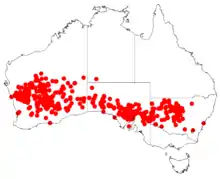Acacia burkittii
Acacia burkittii is a species of wattle endemic to Western Australia, South Australia and western New South Wales, where it is found in arid zones,[3] and is a perennial shrub in the family Fabaceae. Common names for it include Burkitt's wattle, fine leaf jam, gunderbluey, pin bush and sandhill wattle.[3] It has also been introduced into India. Previously this species was referred to as Acacia acuminata subsp. burkittii, but is now considered to be a separate species.[4] Grows in mallee, eucalypt and mulga woodland or shrubland, often on sandhills.[5]
| Burkitt's wattle | |
|---|---|
| Scientific classification | |
| Kingdom: | Plantae |
| Clade: | Tracheophytes |
| Clade: | Angiosperms |
| Clade: | Eudicots |
| Clade: | Rosids |
| Order: | Fabales |
| Family: | Fabaceae |
| Clade: | Mimosoideae |
| Genus: | Acacia |
| Species: | A. burkittii |
| Binomial name | |
| Acacia burkittii | |
 | |
| Occurrence data from AVH | |
Description
Erect or spreading shrub 1–4 m high or sometimes taller; bark finely fissured, dark brown; branchlets terete, glabrous.
Phyllodes straight or curved, terete or subterete, 5–16 cm long, 0.5–1.3 mm wide, obscurely multistriate, usually finely hairy along margins especially towards curved, acute apex; glands absent or 1 inconspicuous gland at base; pulvinus 2–3 mm long.
Inflorescences 2 or 3 in axil of phyllodes; heads ± ovoid or cylindrical, 0.5–1.5 cm long, bright yellow, usually sessile or with peduncles 1–3 mm long. Flowers mostly 4-merous; calyx dissected by 1/2 or more, the lobes usually narrow, with rounded obtuse apices (i.e. ± spathulate).
Pods slightly curved, moniliform, 5–12 cm long, 5–7 mm wide, papery, glabrous; seeds longitudinal; funicle expanded towards seed.
Flowers from July to October.
Taxonomy
The description (by Ferdinand von Mueller) was published in George Bentham's Flora Australiensis in 1864 from a specimen, MEL 2078154,[6] found near Lake Gilles in South Australia, by Burkitt.[2]
Alkaloids
DMT in bark (0.2-1.2%), 0.1% alkaloids from leaves (mostly NMT);[7] 1.5% alkaloids from leaves and stems, mostly tryptamine[8]
References
- "Acacia burkittii". Australian Plant Name Index (APNI), IBIS database. Centre for Plant Biodiversity Research, Australian Government.
- Bentham, G. (1864) Flora Australiensis 2: 400
- "Flora of Australia profile:Acacia burkittii". profiles.ala.org.au. Retrieved 28 July 2019.
- "Acacia burkittii". FloraBase. Western Australian Government Department of Parks and Wildlife.
- "Acacia burkittii". PlantNet. Royal Botanic Gardens, Sydney. 2015.
- MEL 2078154, JSTOR Global Plants. Retrieved 29 July 2019.
- Recent Net reports, Australian underground info
- White, E.P. 1957. “Evaluation of further legumes, mainly Lupinus and Acacia species for alkaloids.” New Zealand J. Sci. & Tech. 38B:718-725